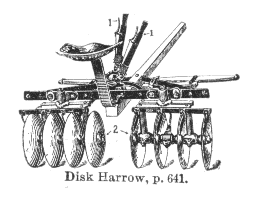Harrow
|
|
Alternative meanings: Horgr, an ancient Germanic place for sacrifice, Harrow, London, a place in the London Borough of Harrow; Harrow School, a famous public school in the United Kingdom; The Harrow, a fantasy and horror magazine.
In agriculture, a harrow is an implement for cultivating the surface of the soil, in this way it is distinct in its effect from the plough, which is used for deeper cultivation. Harrows were originally horse-drawn. In modern practice they are almost always tractor-mounted implements, drawn after the tractor.
Harrowing is often carried out on fields to follow the rough finish left by ploughing operations. The purpose of this harrowing is generally to break up clods and lumps of soil and to provide a finer finish, a tilth, that is suitable for seeding and planting operations. Harrowing may also be used in farming to remove weeds and to cover seed after sowing.
In modern sports grounds maintenance a light chain harrowing is often used to level off the ground, after heavy use, to remove and smooth out boot marks and indentations.
Harrows may be of several types and weights, depending on the intended purpose. They almost always consist of a rigid frame to which are attached disks, teeth, linked chains or other means of cultivation. In the colder climates the commonest types are the disk harrow and the chain harrow but in New Zealand and Australian dairy areas the tine harrow is common. Chain harrows are often used for lighter work such levelling the tilth or covering seed, while disk harrows are typically used for heavy work, such as following ploughing to break up the sod. In addition, there are various types of 'power harrow', in which the cultivators are power-driven from the tractor rather than depending on its forward motion.
A drag is a heavy harrow.
In Europe, harrows were first used in the early Middle Ages.
The following text is taken from the Household Cyclopedia of 1881:
- "When employed to reduce a strong obdurate soil, not more than two harrows should be yoked together, because they are apt to ride and tumble upon each other, and thus impede the work, and execute it imperfectly. On rough soils, harrows ought to be driven as fast as the horses can walk; because their effect is in the direct proportion to the degree of velocity with which they are driven. In ordinary cases, and in every case where harrowing is meant for covering the seed, three harrows are the best yoke, because they fill up the ground more effectually and leave fewer vacancies, than when a smaller number is employed. The harrowman's attention, at the seed process, should be constantly directed to prevent these implements from riding upon each other, and to keep them clear of every impediment from stones, lumps of earth, or clods, and quickens or grass roots; for any of these prevents the implement from working with perfection, and causes a mark or trail upon the surface, always unpleasing to the eye, and generally detrimental to the vegetation of the seed. Harrowing is usually given in different directions, first in length, then across, and finally in length as at first. Careful husbandmen study, in the finishing part of the process, to have the harrows drawn in a straight line, without suffering the horses to go in a zigzag manner, and are also attentive that the horses enter fairly upon the ridge, without making a curve at the outset. In some instances, an excess of harrowing has been found very prejudicial to the succeeding crop; but it is always necessary to give so much as to break the furrow, and level the surface, otherwise the operation is imperfectly performed."de:Egge (Landwirtschaft)

